Click here to watch a video of past Injunior models.
Here, we introduce the watches that were born from IWC. I would like to explain about the Ingenieur, an ultra-antimagnetic wristwatch.
If you are reading this article, you are probably already a big fan of Injunior and understand how great its design is, but what's even more amazing is its actual functionality.
And, I think that some of the people who happen to come across this product are people who work surrounded by electronic devices, so I think that the Injunior will be a good candidate.
How was the Ingenieur, the most powerful antimagnetic watch, created and how did it become so popular among people?
Today, I will explain all of these in detail, so please stay with me until the end.
The history of the birth of Injunior
The Injunior was born in 1955 as a civilian adaptation of the Mark XI that had been created earlier.
What is Injunior? In German it is spelled "Ingenieur" and in Japanese it means "engineer" or "technical engineer."
The original Mark 11 was originally designed for Royal Air Force pilots and is constantly exposed to magnetic fields inside the cockpit.
However, there are jobs in the private sector that involve exposure to magnetic fields. It was manufactured for people in specialized professions, such as doctors and radiologists, who are concerned about the effects of electromagnetic waves.
For more details about Mark 11, please see this article.
So let's take a look at the first model.
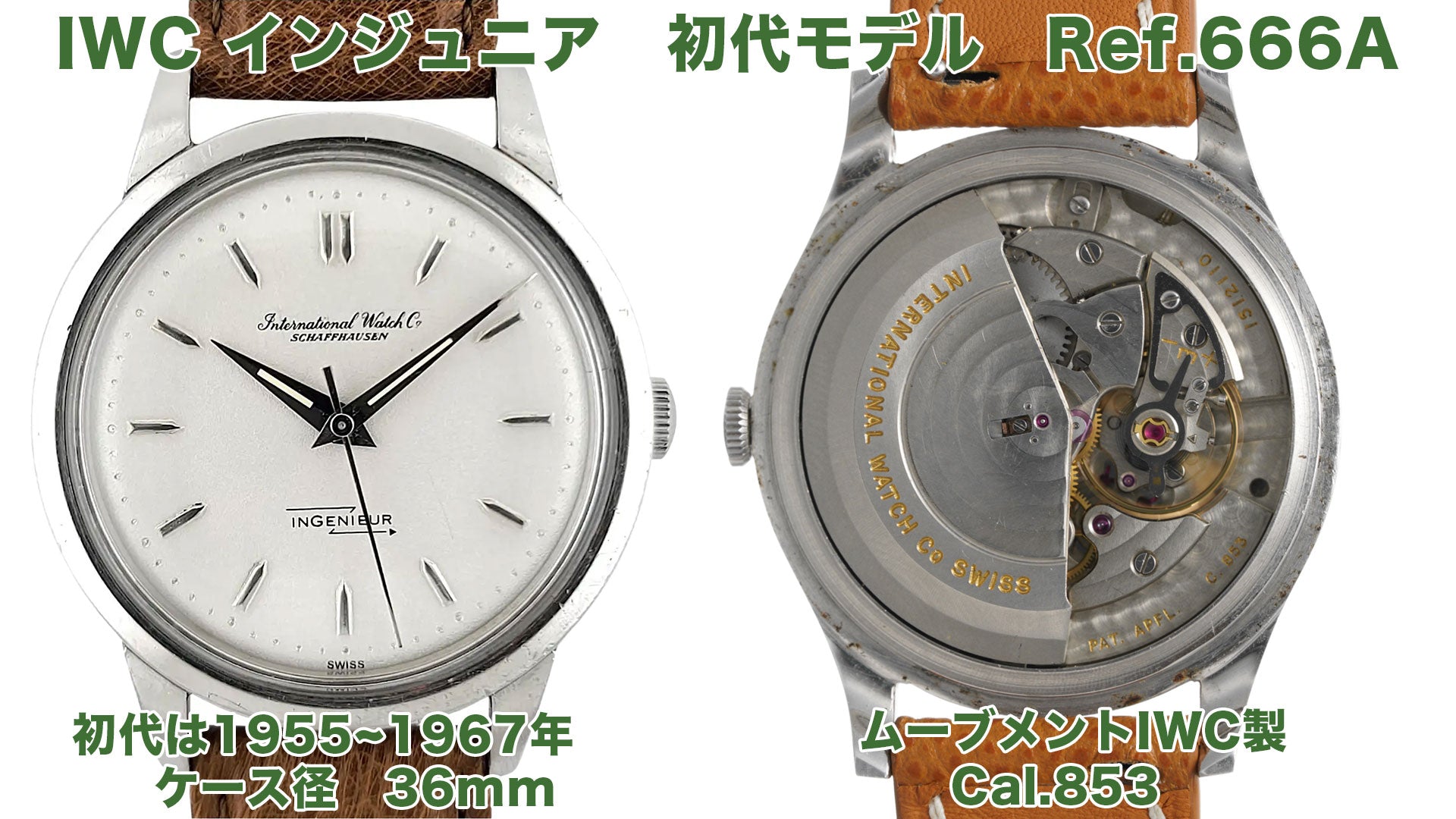
The first model was produced from 1955 to 1967 and was equipped with the Cal. 853 automatic movement without a date display.
Because it was equipped with the latest automatic winding technology at the time, it was priced at about twice the price of other companies' watches with standard automatic winding mechanisms, but as mentioned above, it was sold to white-collar workers such as doctors, engineers, and researchers, and it was an unprecedentedly magnetic-resistant watch, making it a huge hit.
The first model had a magnetic resistance of 80,000 A/m (1,000 gauss).
Next, let's look at how watches were protected from magnetism.
Let's get a rough understanding of how soft iron cases work.
How do you protect your watch from magnetism? This is achieved by encasing the movement in an inner case made of soft iron.
This is getting a bit technical, so I'd like you to just ignore it, but soft iron is a type of iron, but it has a low carbon content, which means it has a low magnetic rate.Magnetic constant is a number that indicates the degree to which something is magnetized when placed in a magnetic field, and a low magnetic constant means that it is less susceptible to the effects of magnetic fields.
And this is housed in a stainless steel case.
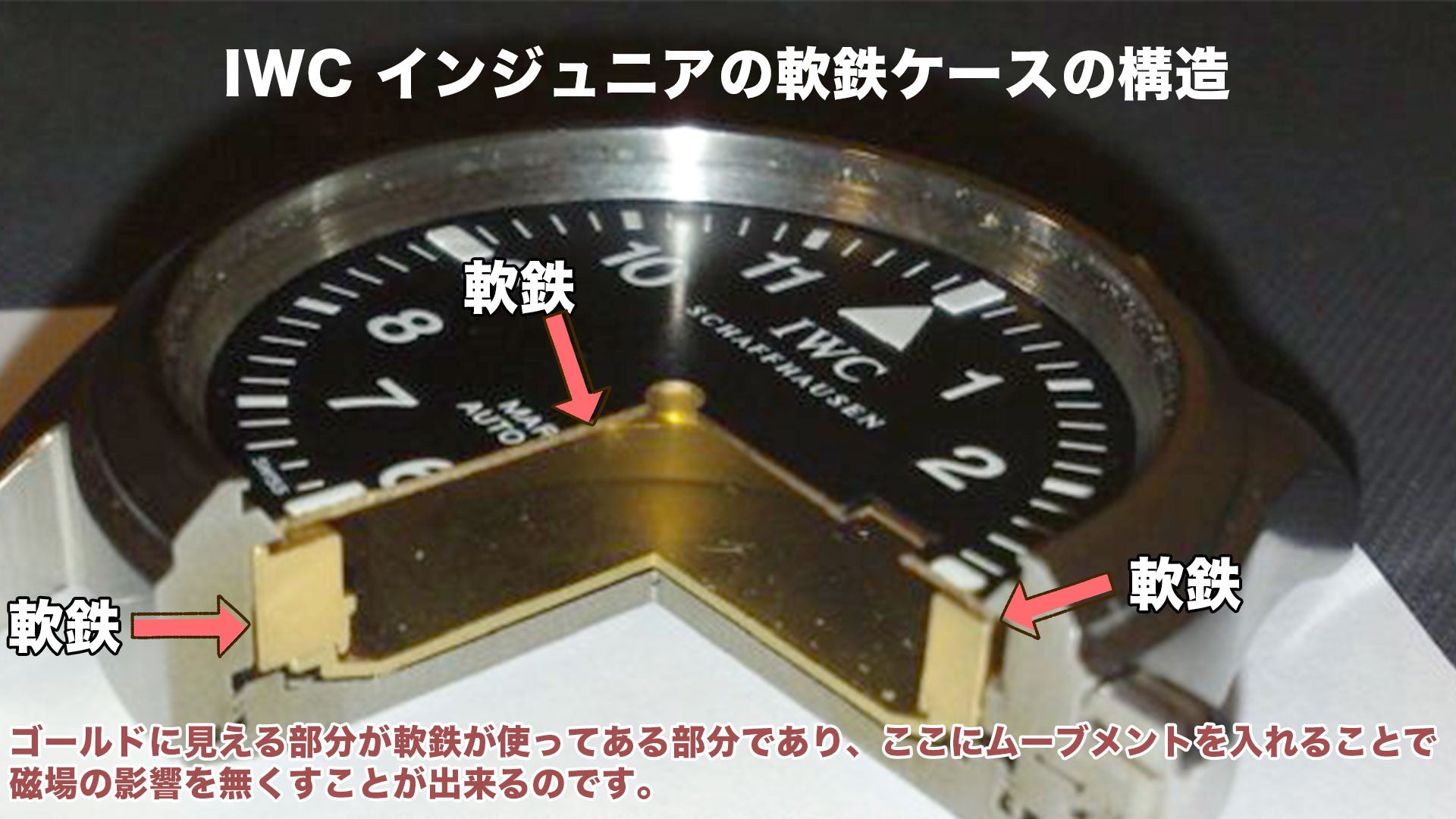
This protects the movement from magnetic fields and ensures that the watch will not go out of sync even in such environments. I know that the meaning of gauss and magnetism may be a little confusing, but to put it very simply, the higher the gauss number, the more resistant the watch is to magnetism.
It's something like 1000→2000→3000 gauss.
And if we use 1000 Gauss as the standard, then if we have this much Gauss, For example, even if you place your watch 1 cm away from a magnetic device such as a smartphone or speaker for around an hour, it will be at a level where it is unlikely to be affected by magnetism.
It is important to understand that just because it uses a soft iron case does not mean it is invincible, but rather that it is resistant to magnetism and not easily magnetized.
The birth of the second generation Injunior

Magnetic resistance is 80,000A/m (1,000 gauss)
The magnetic resistance remains at 1000 gauss.
The second generation model added a date notation and the case diameter increased by 1mm to 37mm.
There are no major design changes, but the indexes and hands are now painted with luminous paint.
One thing not to be overlooked is that the second hand also contains luminous paint.
The movement used is Cal. 584, an evolution of Cal. 583, and through repeated improvements it has been made thinner than the original, making the watch itself even thinner.
The birth of the third generation Injunior
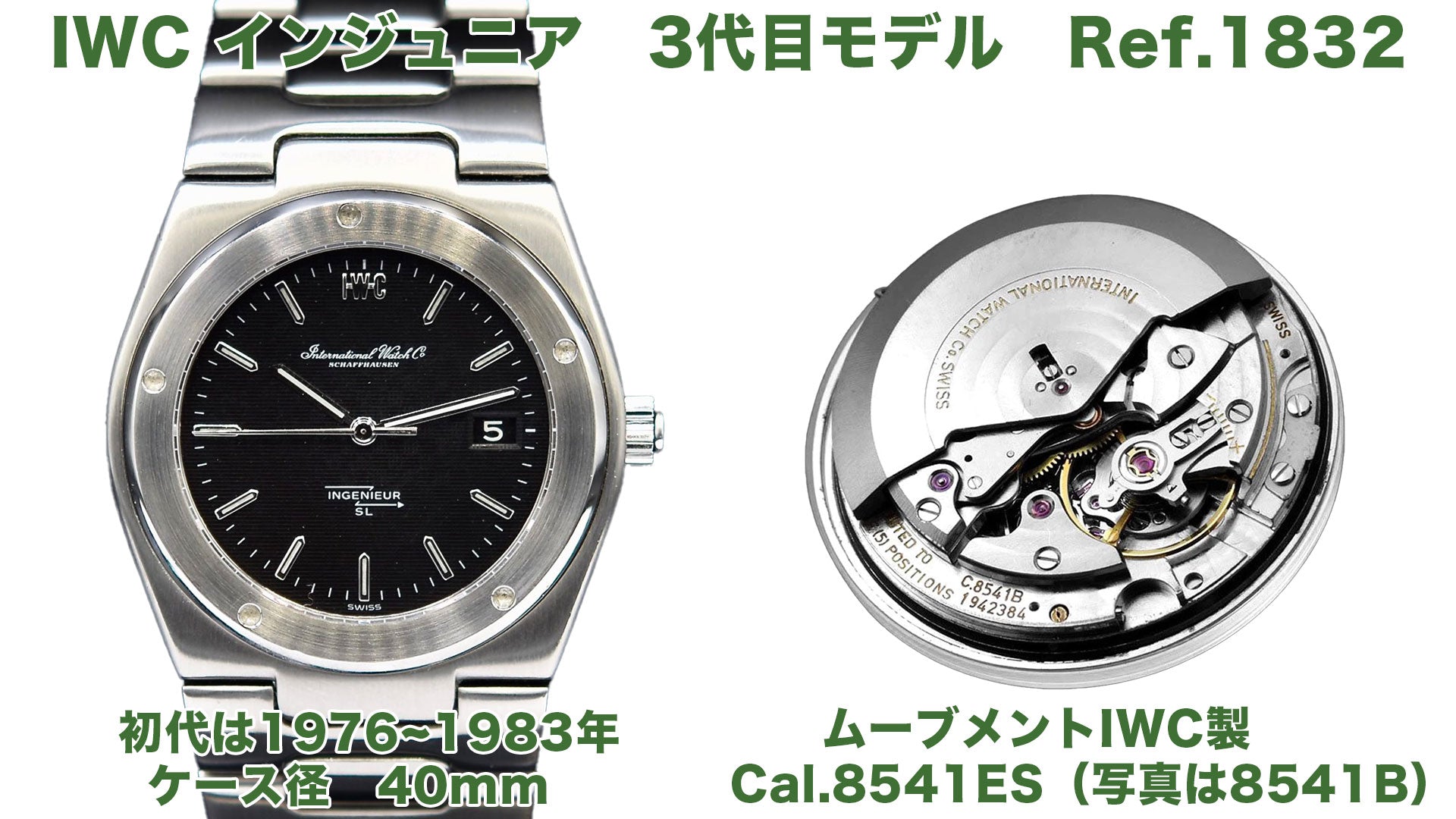
Magnetic resistance is 80,000A/m (1,000 gauss)
The third-generation Ingenieur is characterised by major changes to its design.

It was designed by the famous Gerald Genta and is reminiscent of Patek Philippe's Nautilus and Audemars Piguet's Royal Oak.
The round case is integrated with the bracelet, and the bezel has five rivets, giving it a sporty design.
The 1970s was the heyday of luxury sports cars, and following that trend, the Ingenieur's design was also significantly changed.
However, in reality, very few of these models were produced.
This is because, although it followed the same design as the RagSpo, the case diameter was too large.
The case diameter is 40mm and the case thickness is 12mm.
Nowadays, a 40mm case diameter has become standard, but at the time it was too large and no longer suited the times.
Furthermore, the quartz crisis occurred afterwards, so it could be said that it was a tough time for the third-generation Ingenieur.
Only 976 pieces were produced (534 of which were stainless steel), and this model is now known as the Jumbo, making it one of the rarest models in the Ingenieur series.
4th generation Injunior
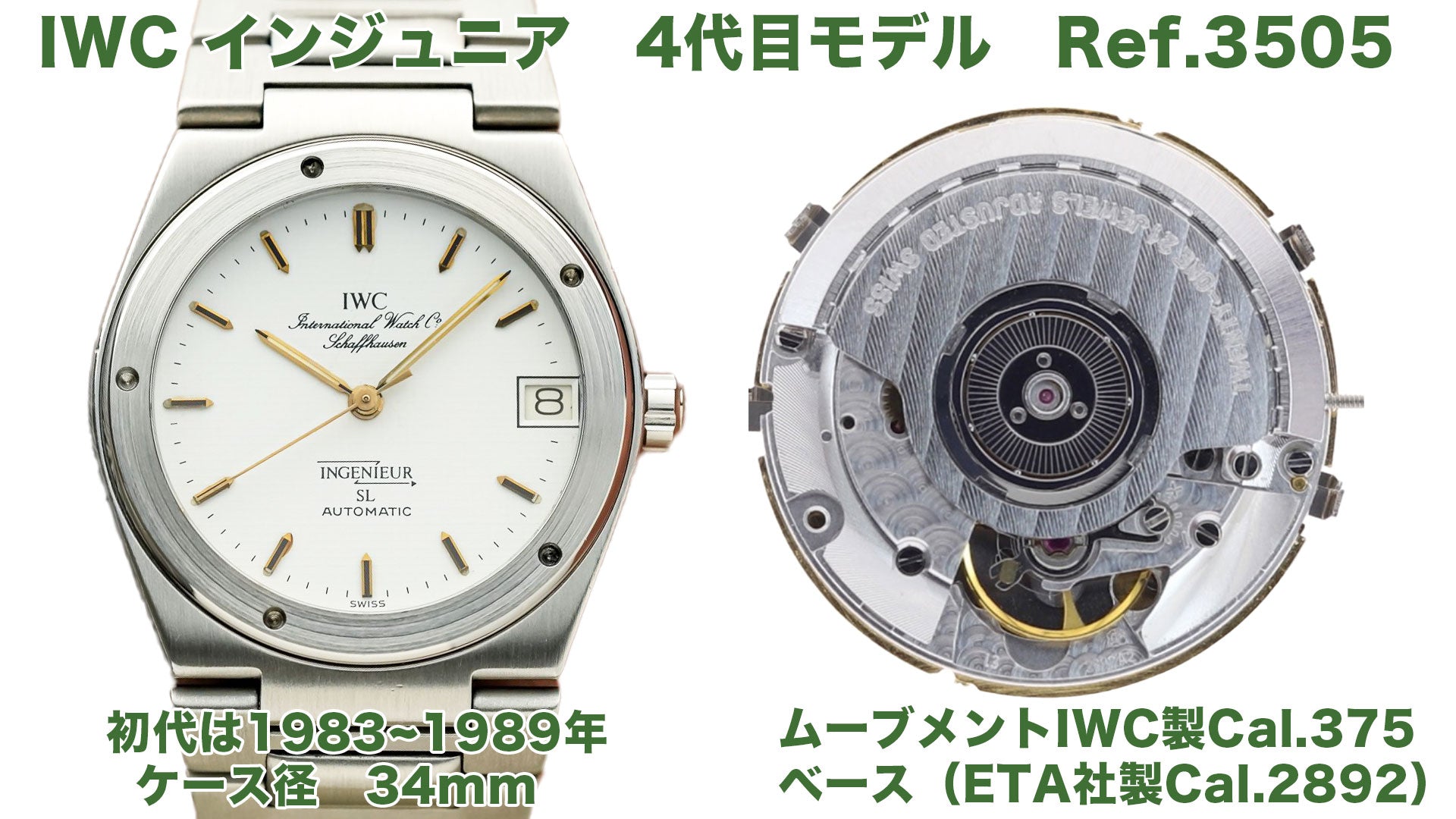
Magnetic resistance is 500,000A/m (6,200 gauss)
Later, in 1983, the next model, Ref. 3505, was reborn with the ETA movement Cal. 375.
The case diameter, which had previously been 40mm, was reduced to 34mm, and the thinner movement also allowed for the case itself to be slimmed down.
What's particularly noteworthy about this model is that it has significantly improved magnetic resistance despite not using a soft inner case.
The magnetic resistance is 6200 gauss.
Compared to the previous model, which had a magnetic resistance of 1,000 gauss, this is six times higher.
How magnetically resistant is it? Generates a very strong magnetic field It even retains its accuracy when exposed to an MRI (magnetic resonance imaging) machine.
Around the 1990s, representative antimagnetic models sold by other companies included Rolex's Milgauss and Vacheron Constantin's Overseas.
Milgauss is 1000 gauss (80,000a/m)
Overseas is 314 gauss (25,000A/m)
In terms of magnetic resistance, the Ingenieur boasts overwhelming capabilities.
How did they improve the magnetic resistance? This model used a niobium-zirconium based alloy in its movement, which eliminated the need for a soft iron inner cage and was able to withstand strong magnetic fields.
In short, this material, niobium zirconium, is not affected by magnetism, so by reviewing the materials used for each part, starting with the parts such as the balance spring that most affect accuracy, an ultra-antimagnetic watch was created.
In 1985, the successor model, Ref. 3506, equipped with Cal. 3753, was produced.
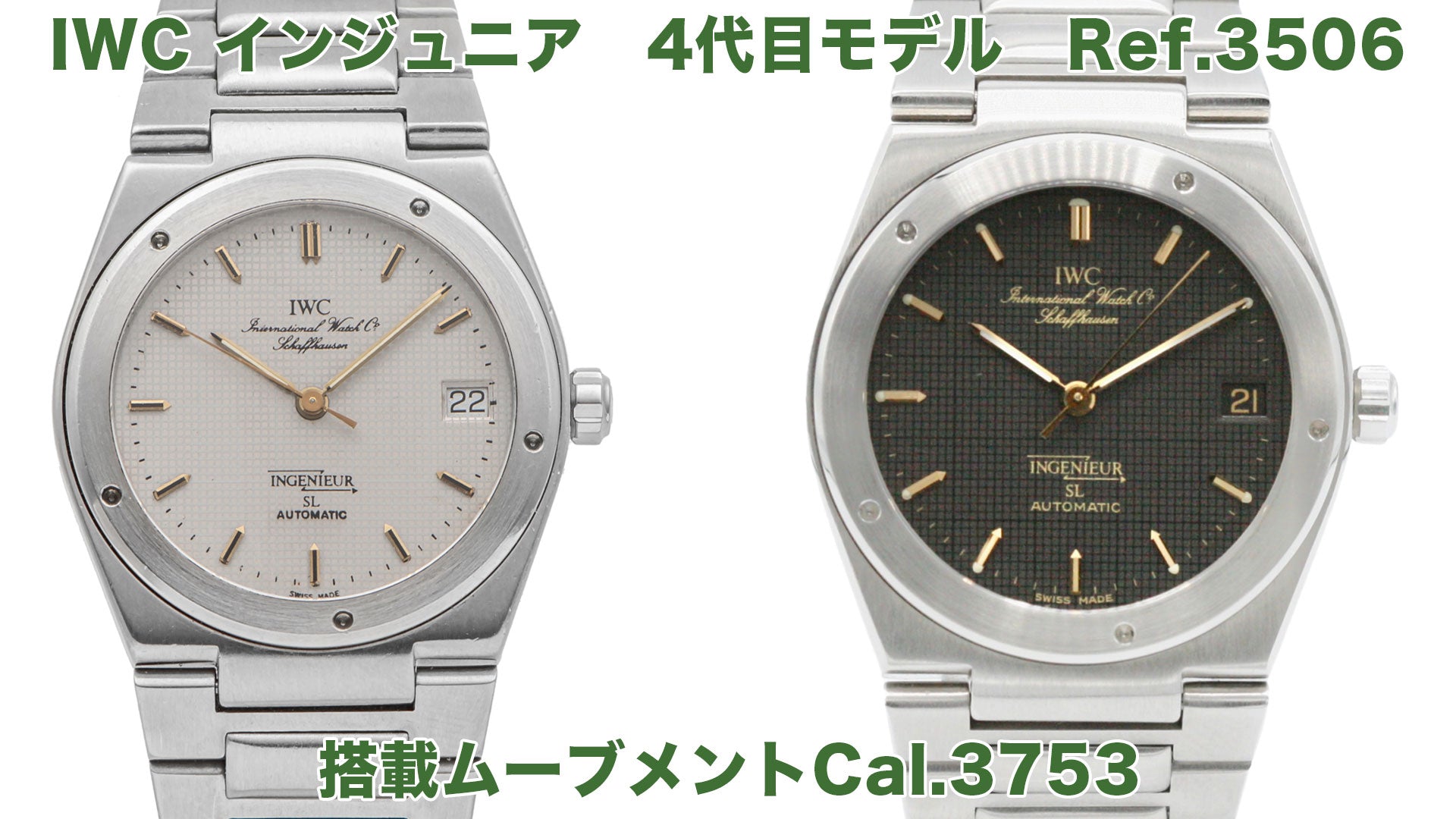
The Ref. 3505 and Ref. 3506 are almost identical, and it's hard to tell where the difference lies, except for the dial.
The successor model, the 3506, has fine lines on the dial, making it look like the Audemars Piguet Royal Oak.
On the other hand, the earlier model 3505 does not have such decoration.
The number of 3505's produced is smaller, making them more rare.
Furthermore, the "SL" designation that has been on the dial since the third-generation model does not represent anything, and the prevailing theory is that it "has no meaning."
5th generation Injunior

The characteristic of the fifth generation Ingenieur is that it is equipped with a movement based on Jaeger-LeCoultre's Cal. 889, converted by IWC to Cal. 887.
As IWC has its own quality standards department, their watches often do not receive external precision testing as "Chronometer" certification. However, as this movement is based on Jaeger-LeCoultre, it has been certified and is marked "OFFICIALLY CERTIFIED CHRONOMETER."
Due to the short production period of just three years and the fact that this model was the only one to be equipped with a Jaeger-LeCoultre movement, this is an extremely rare and highly sought-after model.
When production of this model ended in 2001, the Ingenieur was removed from IWC's lineup.
6th generation Injunior

Magnetic resistance: 80,000A/m (1000 gauss)
Magnetic resistance returns to 1,000 Gauss ( 80,000A/m).
It wasn't until 2005 that the Injunior was reintroduced after a two-year hiatus.
The design retains the riveted screws, but also incorporates big Arabic elements, giving it a modern look.
The most notable feature of this model is its case diameter of 42.5 mm.
While this is a common size today, it is quite large at 8mm compared to the previous model's 34mm size.
At the time, Panerai watches were leading the boom in large, thick watches, so this size was probably chosen to counter that trend.
Two years after its launch in 2005, a minor change was made in 2007.
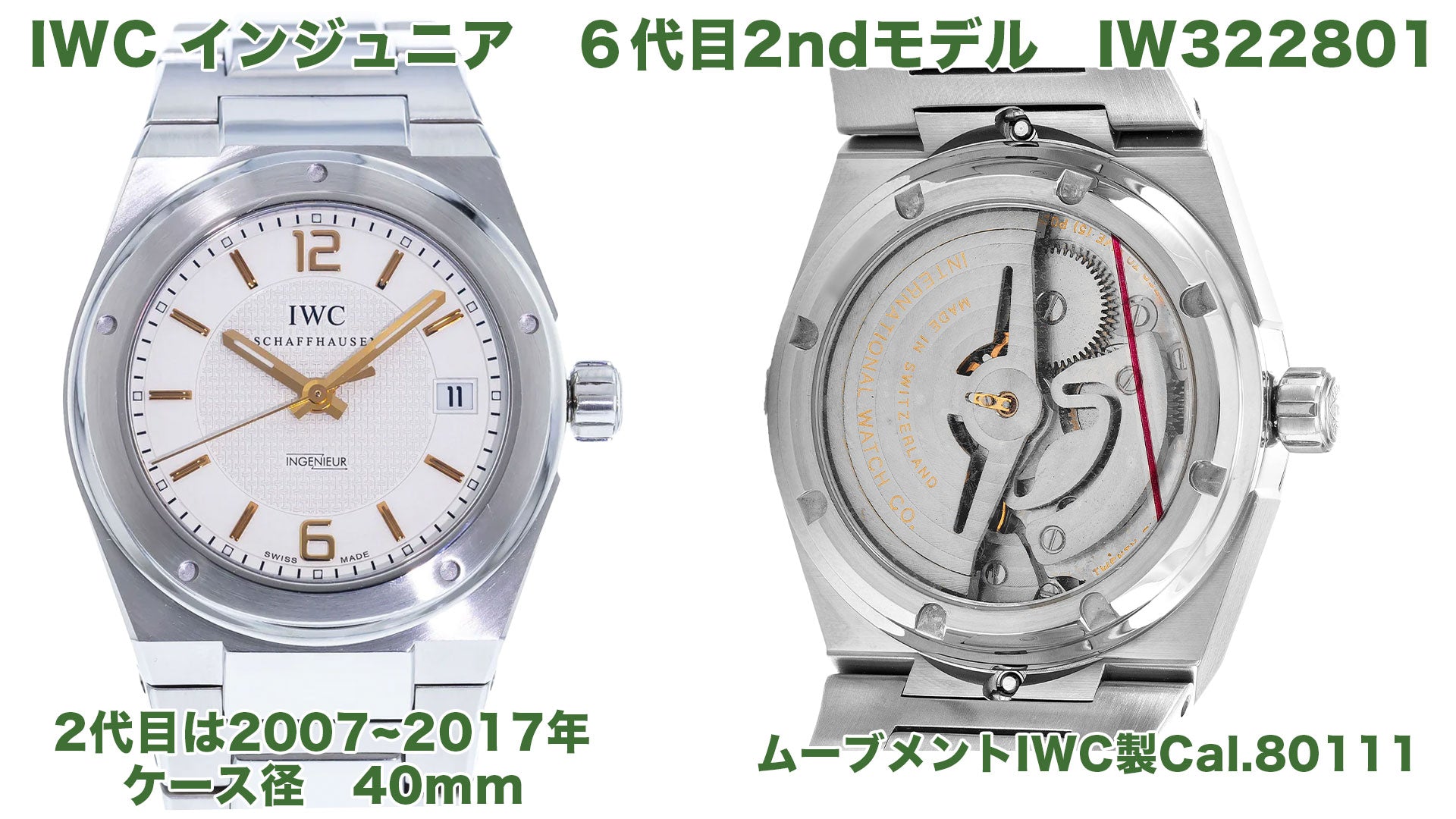
What's particularly noteworthy about this model is that it has a see-through back.
The see-through design allows you to see IWC's traditional Pellaton automatic winding mechanism, but it means that you lose the "ultra-magnetic" feature mentioned at the beginning.
That said, this is only available on the silver dial, and the black dial model uses the same back cover as before.
It could be said that this was a temporary model created in response to requests from people who didn't need a high level of magnetic resistance but still wanted to see a Pellaton-type mechanism.
Therefore, this model is actually produced in small quantities and is highly rare.
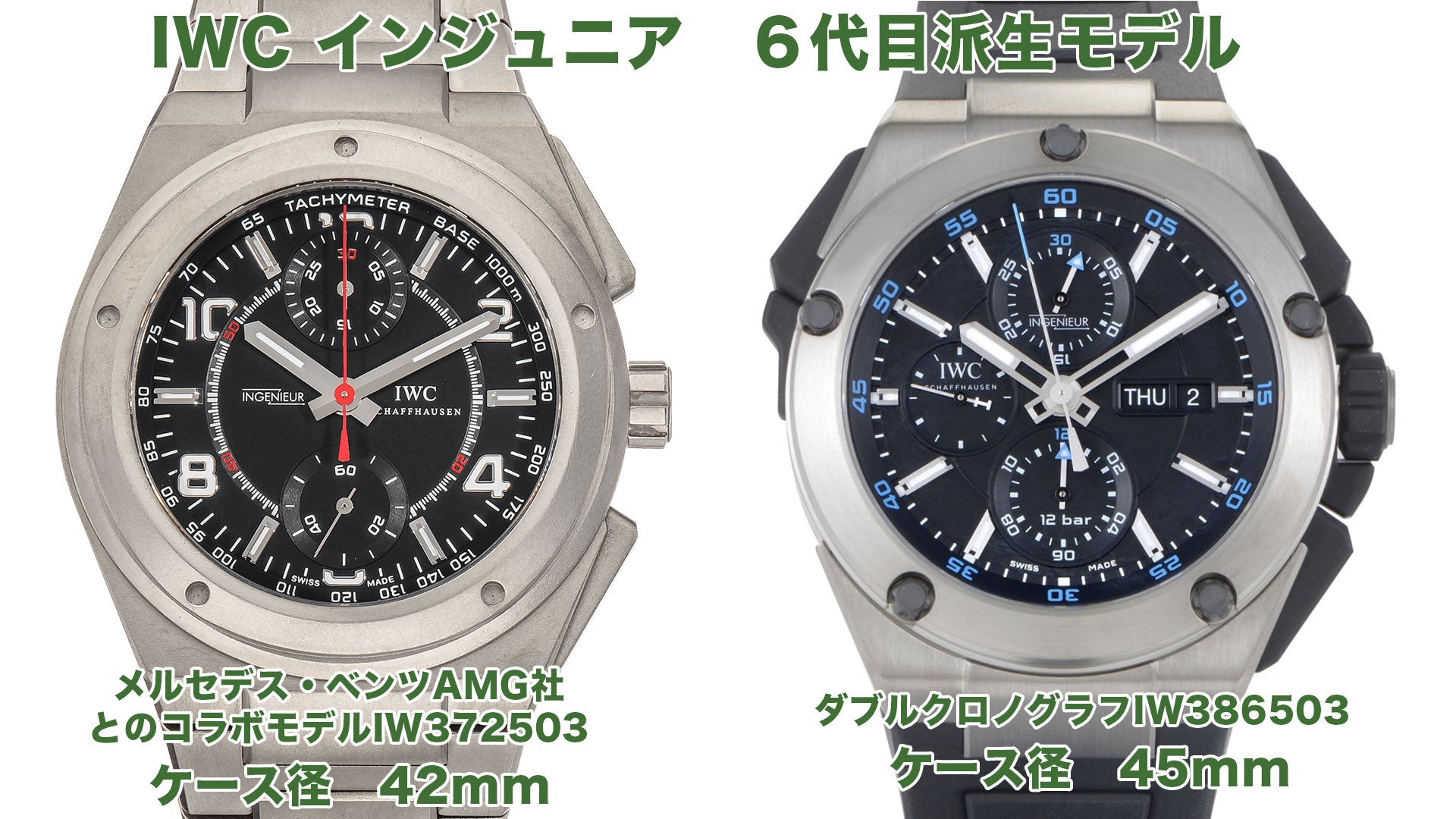
In addition, the sixth-generation Ingenieur also produced a collaborative model with Mercedes-Benz and was equipped with complications and chronograph functions, showing the direction of becoming a derivative and sports watch.
7th generation Injunior
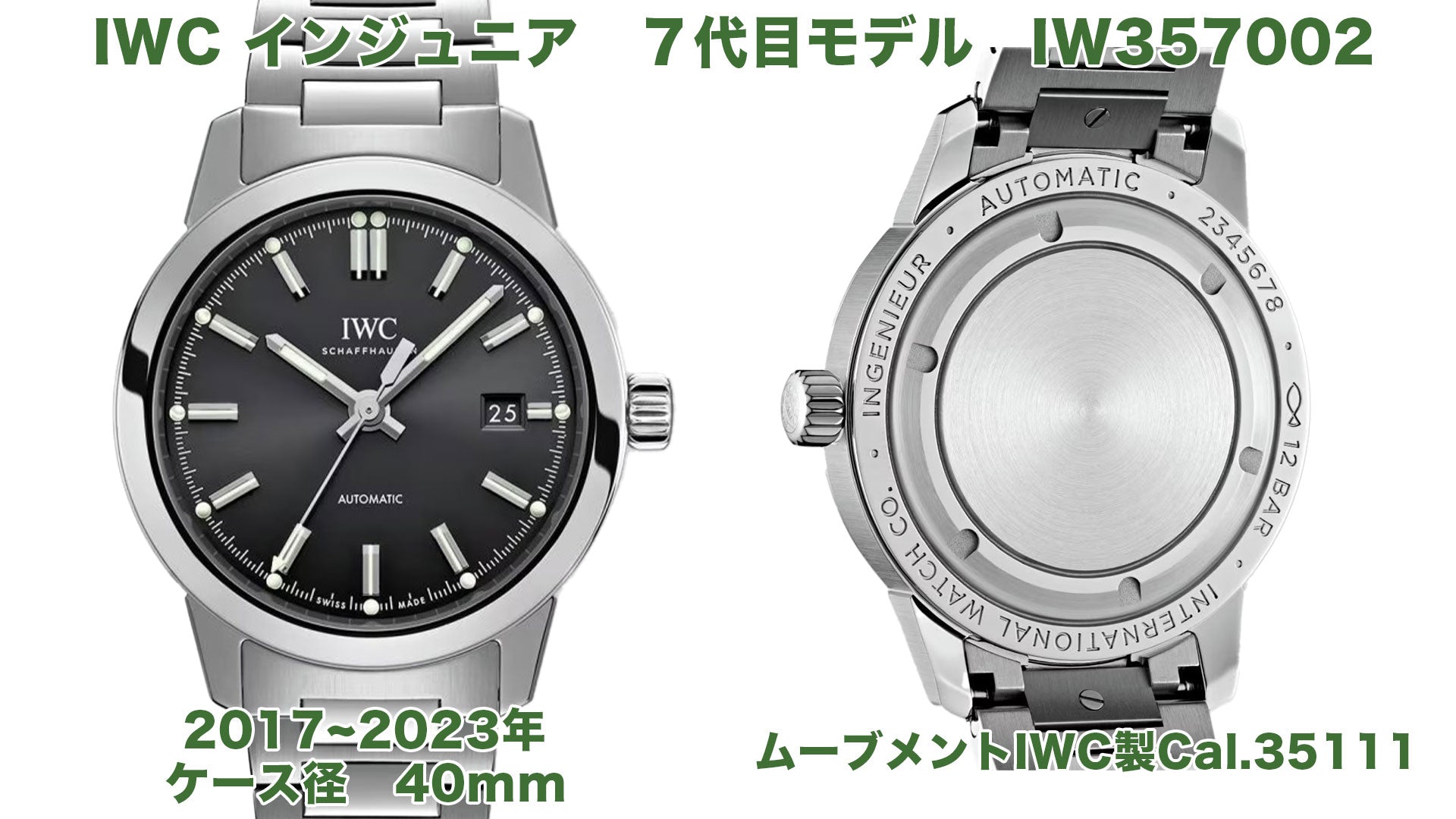
Magnetic resistance: 40,000A/m (500 gauss)
The seventh generation's distinctive feature is that it is quite similar in design to the second generation.
It feels like a modern second generation version.
It has been inherited until now The riveted bezel and big Arabic numerals have been removed, leaving the watch flatter overall, but the robust image is still maintained.
It is quite simply designed, with three hands, bar indexes, a date display and a typical Ingenieur design.
The magnetic resistance is 500 gauss (40,000A/m), half that of the first model, so it is difficult to call it an ultra-magnetic resistant watch, but it is more than sufficient for practical use in everyday life and, with a thickness of just 10mm, it can definitely serve its purpose as a practical watch.
Injunior Chronograph Model
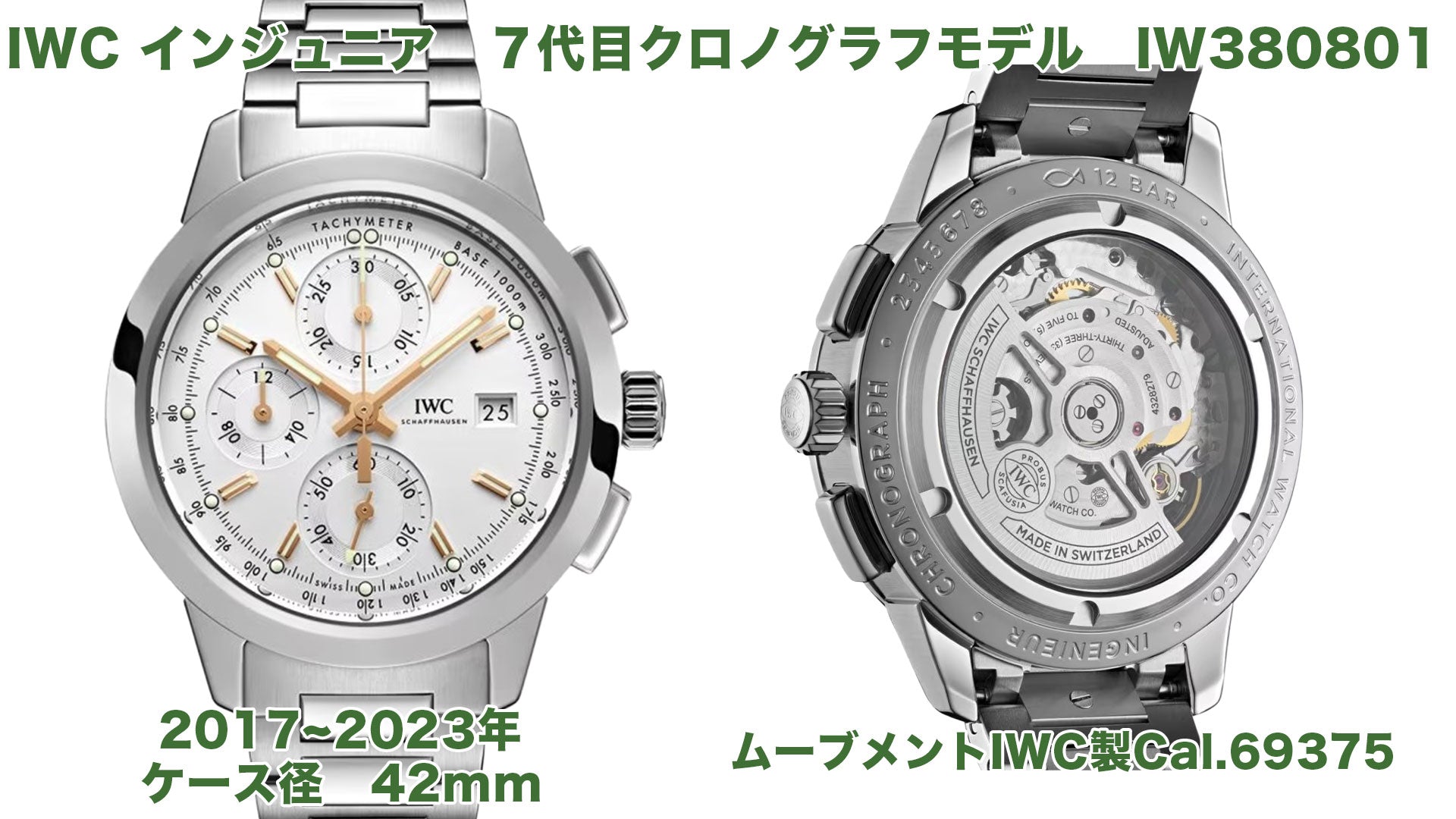
Also born at the same time was the Ingenieur Chronograph Sport with a white dial, which also retains the original Ingenieur design while being equipped with a chronograph function.
This model also features a see-through case back, allowing you to enjoy the chronograph movement.
8th generation Injunior (current model)
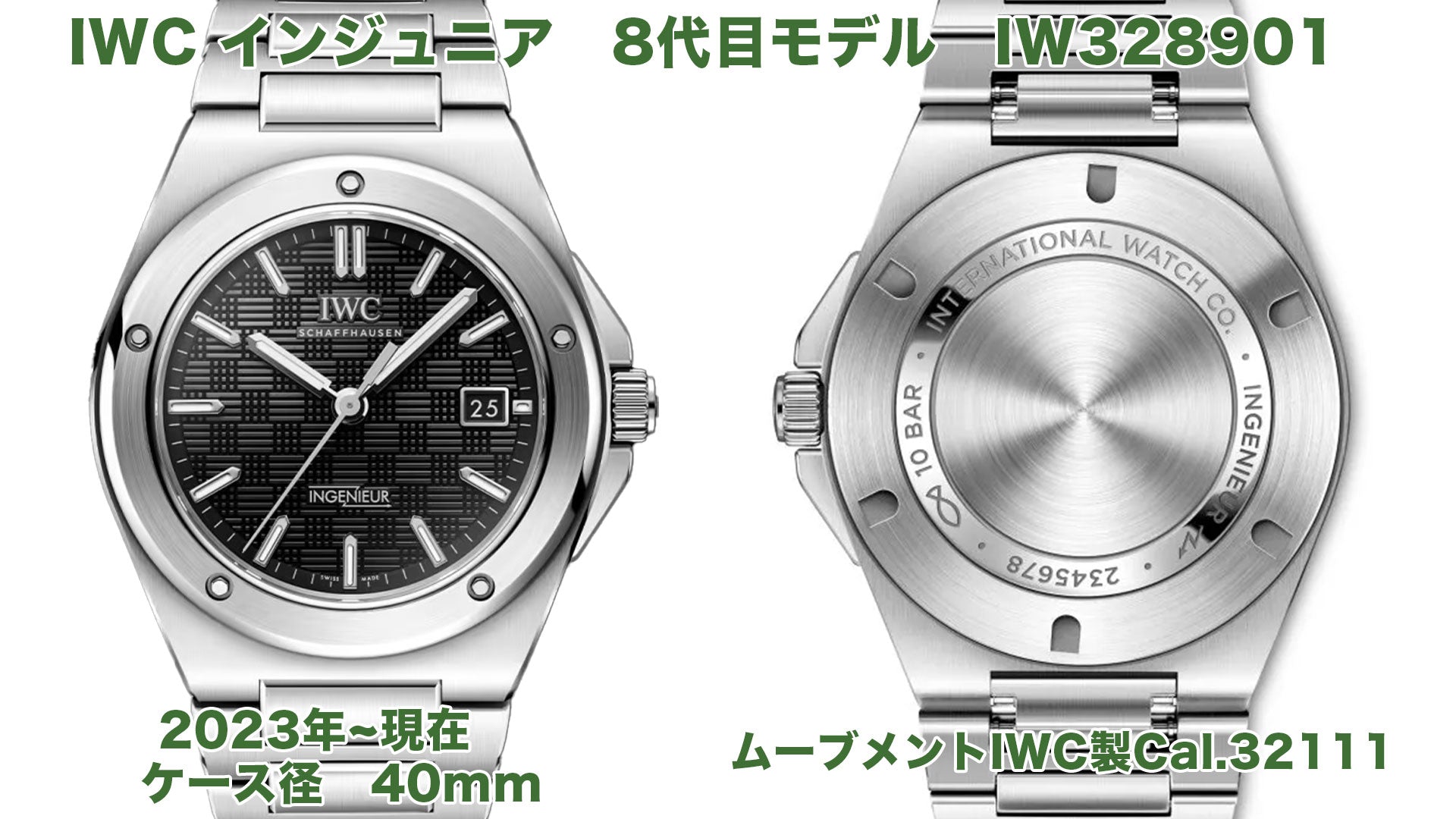
And the latest model, IW328901, was born this year in 2023.
I think this one is closer to the third generation design.
The biggest difference from the third-generation model is that it is the first to be equipped with a crown guard.
Looking at the overall design, it's close to the sleek Patek Philippe Nautilus and should be considered a revival of a Genta design.
The dial also has The uneven grid pattern reduces light reflection and improves visibility.
With a case diameter of just 40mm, it can be described as a modern version of a luxury sport watch.
summary
To sum up, looking back at the history of the Ingenieur, I think that each model from each era has its own appeal and is all connected to IWC's image of robustness.
As the model approached the new one, the magnetic resistance gradually decreased, but this was also in line with the times, and the choice was made to keep what was necessary and eliminate what was not.
If you consider what situations you will wear your Injunior in in your everyday life, you will inevitably be able to determine which model is the best solution.
Both new and old models have their own appeal, and perhaps it is because they were equipped with the most cutting-edge technology of the time that they remain appealing to us living in the modern age.






